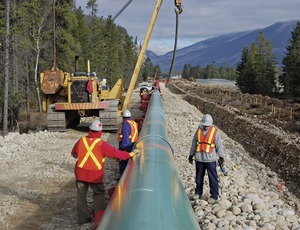
New, long-term contracts with oil- producing companies have prompted Kinder Morgan Canada to expand its proposed twinning of its 714-mile Trans Mountain pipeline between Alberta and Burnaby, British Columbia, and increase by nearly seven times the number of tankers it serves at the port of Vancouver. Company President Ian Anderson said signed agreements with 13 companies "demonstrates the need for this proposed expansion" to serve "existing and new markets."
He continued, "Trans Mountain has an existing footprint, established relationships and a superb safety record. Over the next several months, we'll be doing additional engineering work and studies to assess how the increased capacity will impact the scope of the project."
The additional commitments are expected to increase the pipeline's capacity to 890,000 barrels per day from 750,000 bpd, raise Kinder Morgan's capital investment to $5.4 billion from $5.1 billion and add 29 oil tankers to the five already plying the waters at the port of Vancouver. That scenario sets off alarms with local environmental and aboriginal groups, but Trans Mountain's director of expansion, Greg Toth, tells ENR the real challenges are in areas that are east of Greater Vancouver.
"A lot of things have changed in 60 years. There has been some urban development, so we're looking at routing alternatives in those cases," Toth says. "Some of them are in mountainous terrain with limited construction room, and that may drive some routing alternatives."
Toth says safety and environmental concerns over stream crossings and slope stability likely will result in design decisions not envisioned or even possible six decades ago, when work first began on the Alberta-to-British Columbia pipeline. These decisions may include avoiding wetlands and stream crossings and, where crossing a stream is unavoidable, horizontal directional drilling to pass underneath, a technique used in 2002 on a portion of the existing pipeline.
Toth noted a key difference between Kinder Morgan's existing pipeline and the twinned line will be the increased diameter of the new pipe. Rising in pipe size to 36 in. from 24 in. will not only add capacity by 540,000 bpd, he said; it also will affect the type of oil to be transported once the twinning is completed.
"The smaller-diameter line will be segregated to lighter products—the refined products we ship—like crude oils and synthetic crude oils," Toth notes. "The larger line will predominantly be used for the transportation of heavier crude oils."

Post a comment to this article
Report Abusive Comment